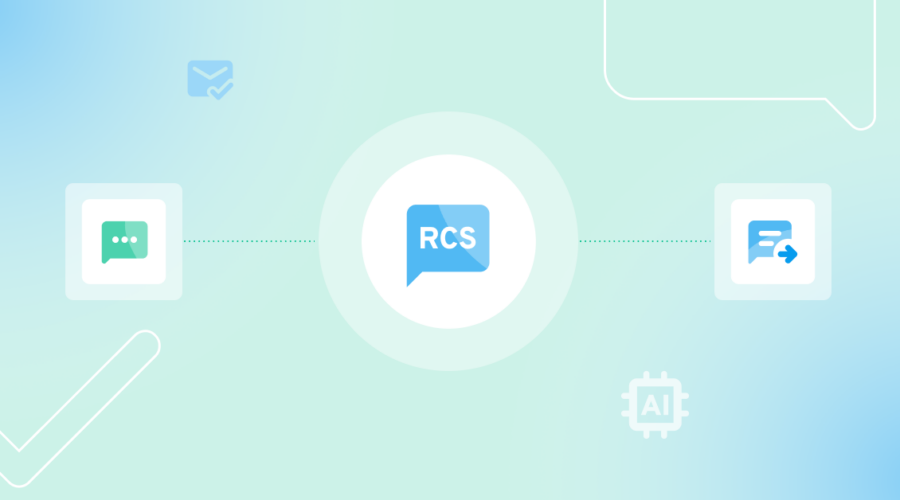Mobile Terminated Messages (MT SMS)
MT SMS, or Mobile terminated SMS messages, are messages terminated on or delivered to a mobile phone. These types of messages are sometimes referred to as ‘short message–mobile terminated’ (SM-MT) or simply ‘mobile terminated messages.‘ MT SMS messages are widely used for applications as disparate as marketing (“Show this voucher for 10% off your next order”) and security–delivering two factor authentication personal identity number (2FA PIN) codes is a well-known example in this context. MT SMS systems also feature the capacity to store undelivered messages and report if delivery has been successful.
As the moniker ‘short message service’ implies, each of these text messages is only able to carry a limited amount of data–140 bytes, or 1120 bits, to be exact. Where 7-bit encoding is used, as is often the case with languages such as English that utilize the Latin alphabet, this works out to 160 characters. The limit for languages that use non-Latin characters such as Arabic and Chinese, which generally require 16-bit encoding, is 70 characters. SMSs are also used to send ringtones, configuration settings, animations and anything else that can fit within its 140-binary data limit.
That such limits exist may surprise many modern-day texters, who regularly send SMSs that are hundreds of characters long. The technology that makes this possible is called concatenated SMS, long SMS or multipart SMS. This is how it works: the sender device splits long messages into smaller segments, each of which is sent as a separate SMS. The recipient phone then assembles these individual segments to recreate the original message.
Mobile Originated Short Message Service (MO SMS)
Mobile originated SMSs (MO SMS) and MT SMSs are closely related and worth brief discussion. MO SMSs are messages that originate from a sender device, eventually terminating at a recipient device. Messages from marketers, notifications from banks and alerts from services such as Google Calendar and iCal are all forms of MO SMSs.
The history of MT SMS
The foundations of the virtual infrastructure that supports the sending and receiving of MT SMS–and text messages in general–were laid down in the 1980s as part of the process of designing and developing the Global System for Mobile Communications (GSM) technology. SMS are transmitted over the so-called ‘signaling layer’ or ‘signaling channel’ of the GSM network. In digital fixed telecommunications, this channel is used for keeping an eye on the network. During the development of GSM, experts realized that it did not utilize this channel in a similar fashion and thus offered room for sending short text-based alphanumeric data during speech transmission.
Widespread adoption of GSM, first in Europe and then in much of the rest of the world fostered the growth of text messaging. Eventually, SMS was incorporated into the Code Division Multiple Access (CDMA) cellular technology that is widely used in the United States and certain other parts of the globe.
The history of SMS in its early days is also the history of MT SMS; carriers initially viewed text messaging essentially a glorified paging system, a unidirectional tool for sending alerts and notifications to business customers. As the technology matured and carriers figured out ways of billing customers for text messaging, the technology gradually morphed into the bidirectional communication system we are familiar with today.
GSM and SMS standards were originally developed by the European Telecommunications Standards Institute (ETSI). The Third Generation Partnership Project (3GPP) eventually took over responsibility for developing and maintaining standards for these symbiotic technologies.
MT SMS call flow
An MT SMS originates from a sender device, which can be a phone, web server, personal computer or even a fax. The message is transmitted to an SMS center (SMS-C), which routes it to its destination. An MT SMS may pass through several centers before reaching the recipient device.
The SMS-C gets routing information from a carrier’s Home Location Register (HLR), a permanent record containing details of all its mobile subscribers. Once it has that information, the SMS-C forwards the message to whichever mobile switching center (MSC) is closest to the recipient; MSCs keep track of cellphone locations for seamless call and SMS routing.
The MSC consults the Visitor Location Register (VLR), a temporary, constantly updating record of subscribers roaming within its service area, to locate the right mobile subscriber (MS) device. The MSC then queries the base station controller (BSC) closest to the MS; BSCs are responsible for network traffic measurement, authentication and handover management. The BSC then communicates with the recipient device, conducts authentication, and relays the results of the process back to the MSC.
If authentication is successful, the MSC transmits the MT SMS to the MS, which confirms receipt by sending a delivery report that is relayed back to the SMS-C. The SMS-C then informs the sender about the outcome of the process. If delivery fails, the SMS-C alerts the sender and stores the MT SMS for anywhere between 24 hours and a week, depending on how the SMS-C system is configured, as it re-attempts transmission. If repeated delivery attempts result in failure, the SMS-C informs the sender and purges the MT SMS from its systems.
Types of MT SMS
Application to Person (A2P)
As the name implies, these are mobile terminated text messages originating from applications. A2P MT SMSs are usually–but not always–unidirectional. Appointment reminders and 2FA PIN codes are good examples of A2P messages.
Person to Person (P2P)
These are MT SMSs that originate from another person rather than an application. P2P messages are usually bidirectional.
Check out the video below to learn more about A2P vs. P2P SMS.
SMS classes
SMS classes indicate the importance of a particular message and identify where it should be stored. There are four SMS classes.
Class 0
Class 0 MT SMSs are immediately displayed on the device screen on receipt. They are not saved, unless the recipient explicitly chooses to do so. Once the message is displayed, a delivery report is sent back to the SMS-C. These types of messages are sometimes referred to as flash SMSs.
Class 1
Class 1 MT SMSs are saved in the device or subscriber identity module (SIM) card. Storage is contingent on availability of adequate space.
Class 2
Class 2 MT SMSs carry SIM card data. Once data is successfully transmitted to the card, a delivery acknowledgment is sent to the SMS-C. If the transfer fails, an error message is sent instead.
Class 3
Class 2 MT SMSs are forwarded from the recipient device to another party. A delivery report acknowledging receipt is sent to the SMS-C when the primary recipient gets the message, not when it is forwarded to another device.
Some of the ways enterprises use MT SMS
SMS marketing
Unlike other marketing tools such as television advertising and social media memes, SMS marketing provides excellent granularity. For instance, food vendors can send MT SMSs to their customers right about the time people are most likely to be looking for something to eat. The messages can even be tailored for different audiences or specific locations; for instance, some stores place signs in strategic locations inviting shoppers to sign up by text message to receive discounts and new product alerts.
Providing tips and advice
A variety of businesses use MT SMSs to furnish clients with helpful tips and advice. For instance, doctors and dentists can use MT SMSs to send messages to their patients contaning useful advice on postoperative care. Some healthcare firms send MT SMS blasts with tips on healthy eating. As another example, KCRW, a National Public Radio member station, uses text messages to provide restaurant recommendations to its members, to name just a few examples.
Improving customer service
Brands leverage MT SMSs to foster a closer connection with their clients. For instance, some firms use these messages to keep customers updated about their loyalty points. Others have integrated MT SMS systems into their online booking processes to prevent fraud and make check ins and check outs easier. Some spas, restaurants, resorts and healthcare providers use MT SMSs to alert clients about upcoming appointments.
Follow up
A number of firms use MT SMSs to encourage clients to provide feedback. For instance, some concert organizers send texts to people who have attended their events asking them to visit their websites and provide feedback.
Other uses
There are numerous other uses for MT SMS including:
- Last-minute schedule changes
- Grade update alerts from teachers to students
- Alert repair and maintenance crews about issues that require their attention
- Soliciting donations
- Updating people during emergencies
How does Bandwidth encode its SMS messages?
When sending SMS messages, Bandwidth will automatically send messages in the most compact encoding possible. If there are any non GSM-7 characters in your message body, Bandwidth will automatically change to UCS-2 encoding (which will limit message bodies to ~70 characters each depending on the number of segments).
For concatenated messages, Bandwidth prepends a User Data Header of 6 Bytes (the UDH instructs the receiving device on how to assemble messages), leaving 153 GSM-7 characters or 67 UCS-2 characters for your message.
Encoding for SMS depends on the platform you use:
| Platform | Outbound (MT) | Inbound (MO) |
| SMPP | Bandwidth passes through the encoding type present in the message | Bandwidth passes through the encoding type present in the message |
| HTTP (using V1 API) | Bandwidth will select the most compact encoding that can represent the message text. The set of possible encodings, from smallest to largest is: GSM → Latin1→ Cyrillic → Hebrew → UCS2 | Message text will always be in JSON format with UTF-8 encoding |
| HTTP (using V2 API) | Bandwidth uses GSM 8-bit encoding, or UCS-2 if the message text contains non-ASCII characters | Message text will always be in JSON format with UTF-8 encoding |
What are the benefits of Bandwidth’s messaging services like MT SMS
At Bandwidth, we understand how important messages are when connecting businesses to their customers. Whether your business uses messaging to remind someone about tickets to hear their favorite band or about an appointment to hear their baby’s first heartbeat, your messages matter to us.
That’s why Bandwidth provides a Messaging API that sits atop our own network. Our customers experience fast, reliable messaging solutions that can grow with your business. Since we own and operate the network, you get to avoid the middleman. Your business can enjoy cost savings on effective, scalable messaging solutions which allows you to get back to what matters most.




